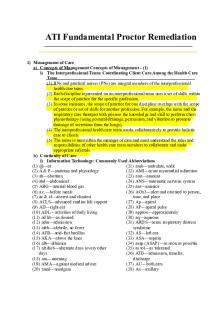ATI Proctor RN Pharmacology 2019 PDF

| Title | ATI Proctor RN Pharmacology 2019 |
|---|---|
| Course | Professional Nursing 2 |
| Institution | Rasmussen University |
| Pages | 3 |
| File Size | 62.3 KB |
| File Type | |
| Total Downloads | 75 |
| Total Views | 181 |
Summary
Download ATI Proctor RN Pharmacology 2019 PDF
Description
ATI Proctor RN Pharmacology 2019 Remediation Postpartum Nurses, Nurse Manager, Charge Nurse, Director Nurse 1. Legal Responsibilities: Responding to a client who refuses to receive a vaccine a. Clients have the right to refuse treatment, including the right to leave a health care facility without a discharge prescription from the provider. b. If the client refuses a treatment or procedure, the nurses and the providers discuss the risk involved with refusing the treatment or procedure. c. The nurse asks the client to sign an "Against Medical Advice" form and documents the incident. 2. Fluid Imbalances: Identifying manifestations of fluid volume deficit a. Vital signs: Hypothermia (hypovolemia) or hyperthermia (dehydration), tachycardia, thread pulse, hypotension, hypotension, tachypnea, hypoxia b. Neuro-musculoskeletal: Dizziness, confusion, weakness, fatigue; seizures c. GI: Thirst, dry mucous membranes, dry furrowed tongue, nausea, vomiting d. Renal: Oliguria e. Other findings: Diminished capillary refill, cool clammy skin, diaphoresis, sunken eyeballs, flattened neck veins, absence of tears, decreased skin turgor. 3. Antibiotics Affecting protein synthesis: Planning care for a client prescribed erythromycin lactobionate a. Administer erythromycin lactobionate with meal b. Monitor for and report adverse GI effects c. Monitor liver function test d. Can not use with drugs: verapamil and diltiazem, HIV protease inhibitors, antifungal medications and nefazodone --> can cause toxicity. 4. Individual considerations of medication administration: risk factors for adverse reactions in older adult clients a. Often with reduced liver and kidney function, may require proportionally smaller medication doses b. Decreased renal function is the major cause of medication accumulation leading to toxicity c. Impaired memory or altered mental state d. Changes in vision and hearing e. Decreased mobility and dexterity f. Poor adherence g. Reduced financial resources 5. Bipolar disorders: intervention for a lithium level: a. < 1.5 mEq/L: i. hold med, notify provider ii. given new dose based on new levels 1
b. 1.5 mEq/L – 2 mEq/L: iii. hold med, notify provider iv. given new dose based on new levels v. promotion of excrete may be necessary if severe c. 2.0 mEq/L – 2.5 mEq/L: i. give alert client emetic. ii. perform gastric leave or admin urea, mannitol iii. Or aminophylline to increase rate of secretion d. > 2.5 mEq/L: Hemodialysis 6. Antibiotics Affecting the bacterial cell wall: contraindications for client who has anaphylactic reaction to penicillin a. A history of severe allergic reactions to penicillin, cephalosporin, or imipenem is a contraindication for penicillin. b. Clients who are allergic to one penicillin are cross-allergic to other penicillin and are at risk for cross-sensitivity to cephalosporin. 7. Growth factors: Preparing to administer Epoetin Alfa a. Administer by SQ or IV bolus injection. Dosage is based on client’s weight 8. Medications affecting coagulation: clarify a prescription with provider a. baseline VS b. CBC, platelet count, hematocrit levels c. check dosage w/another nurse 9. Dosage calculation: administering sulfadiazine tablets in divided doses a. Mg/kg/day divide dose. Count mg/day then divide by 2 10. Total parenteral nutrition: Initiating therapy a. On initiation of TPN, the rate is increased gradually to the prescribed rate to help prevent hyperglycemia. b. Nursing interventions include assessing clients daily weight, nutritional status, and blood glucose check per prescription. 11. Endocrine disorders: evaluating therapeutic effect of levothyroxine a. ↓TSH levels b. normal T4 levels c. absence of hypothyroidism symptoms (depression, weight gain, bradycardia, anorexia, cold intolerance, dry skin, menorrhagia) 12. Diabetes mellitus: evaluating adherence to the treatment plan a. Pre-prandial glucose levels from 90 to 130 mg/dL b. Post-prandial glucose...
Similar Free PDFs

ATI Proctor RN Pharmacology 2019
- 3 Pages

ATI pharmacology proctored ATI 2019
- 20 Pages

ATI- OB Proctor Remediations
- 3 Pages

ATI Proctor Fund Remediation
- 25 Pages

ATI Pharmacology
- 11 Pages

RN Maternal Newborn 2019 ATI exam
- 12 Pages

Ati med surg quiz - ati proctor
- 4 Pages

ATI - Pharmacology Testing Questions
- 26 Pages
Popular Institutions
- Tinajero National High School - Annex
- Politeknik Caltex Riau
- Yokohama City University
- SGT University
- University of Al-Qadisiyah
- Divine Word College of Vigan
- Techniek College Rotterdam
- Universidade de Santiago
- Universiti Teknologi MARA Cawangan Johor Kampus Pasir Gudang
- Poltekkes Kemenkes Yogyakarta
- Baguio City National High School
- Colegio san marcos
- preparatoria uno
- Centro de Bachillerato Tecnológico Industrial y de Servicios No. 107
- Dalian Maritime University
- Quang Trung Secondary School
- Colegio Tecnológico en Informática
- Corporación Regional de Educación Superior
- Grupo CEDVA
- Dar Al Uloom University
- Centro de Estudios Preuniversitarios de la Universidad Nacional de Ingeniería
- 上智大学
- Aakash International School, Nuna Majara
- San Felipe Neri Catholic School
- Kang Chiao International School - New Taipei City
- Misamis Occidental National High School
- Institución Educativa Escuela Normal Juan Ladrilleros
- Kolehiyo ng Pantukan
- Batanes State College
- Instituto Continental
- Sekolah Menengah Kejuruan Kesehatan Kaltara (Tarakan)
- Colegio de La Inmaculada Concepcion - Cebu







